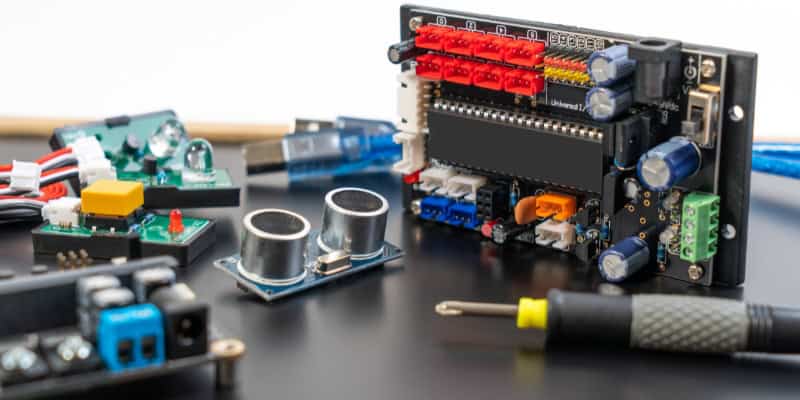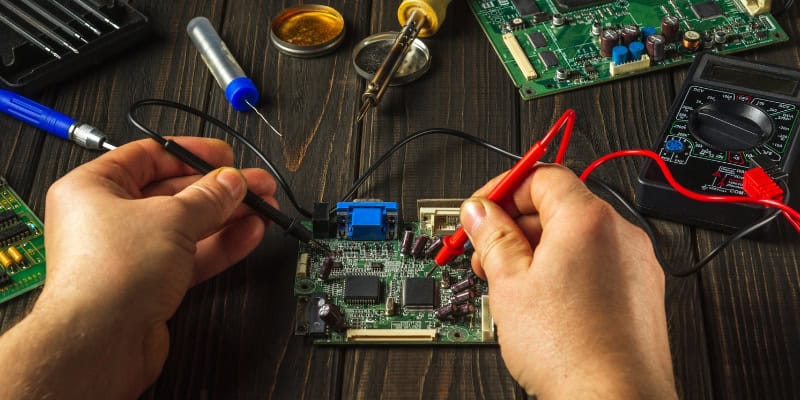IoT Hardware Designing Process Key Considerations & Emerging Trends

Explore key considerations for an effective IoT hardware designing process & Learn to design efficient, scalable & secure IoT devices for any industry.
The Internet of Things (IoT) has transformed the way devices interact, collect data, and communicate in real time. From smart homes to industrial automation and healthcare, IoT is driving innovation.
The foundation of any IoT system lies in its hardware, Thus designing efficient IoT hardware is crucial for ensuring seamless performance, security, and scalability.
Understanding the key considerations and best practices of IoT hardware design is essential for developers and companies looking to create innovative solutions.
In this blog, we will explore the essentials of IoT hardware design. Let’s get started!
Key Components of IoT Hardware
Sensors
Sensors are the primary input devices in an IoT system, They detect and collect real-world data and then convert physical changes into electrical signals, which are later processed by the IoT device.
Sensors can be categorized into various types based on their functionality:
Environmental sensors: They measure factors like temperature, humidity, air pressure, and air quality. It is commonly used in weather monitoring, HVAC systems, and industrial safety.
Motion Sensors: These include accelerometers, gyroscopes, and magnetometers to detect movement in wearables, smartphones, and automotive applications.
Optical Sensors: IoT sensors detect ambient light, infrared (IR), and ultraviolet (UV) radiation, commonly used in smart lighting security cameras, and environmental monitoring.
Proximity and distance Sensors: They use ultrasonic, LiDAR, and Time of Flight(ToF) technology to detect object presence or measure distance. Mostly found in automated doors, robotics, and smart parking systems.
Biometric Sensors: Measures physiological parameters like heart rate, blood oxygen levels, and fingerprints.
Chemical Sensors: IoT chemical sensors detect gases, PH levels and other chemical compositions, They are useful in air quality monitoring, industrial safety and agriculture.
Actuators
Actuators enable IoT devices to take actions based on processed data. They convert electric signals into physical movements.
For example, A smart thermostat uses an actuator to adjust the heating or cooling based on temperature sensor readings.
Common types of actuators in IoT hardware include:
Motors (DC, Stepper, Servo): Used in robotics, automated doors, and industrial machines to enable precise movement.
Solenoids: Electromagnetic actuators found in smart locks, valves, and fluid control systems.
Relays: Electrically operated switches that control high-power devices like home appliances, HVAC systems, and industrial equipment.
Piezoelectric Actuators:* Generate motion using electrical voltage, commonly used in precision positioning systems, haptic feedback, and medical devices.
Pneumatic or Hydraulic Systems: Use air or fluid pressure to perform heavy-duty mechanical movements, often found in factory automation, agriculture, and automotive applications.
Microcontrollers (MCUs) and System-on-Chip (SoC)
MCUs and SoCs act as the brains of IoT devices, They handle computation, data processing, and communications.
Key components of MCUs and SoCs:
CPU: Often based on ARM Cortex-M series (e.g., M0+, M3, M4, M7) or RISC-V architectures
Memory: Chip RAM is used for temporary data storage, and flash memory is used for program storage and execution.
Peripherals: Integrated components like Analog-to-Digital Converters (ADCs), Digital-to-Analog Converters (DACs), timers, and communication interfaces (UART, SPI, I2C) for seamless interaction with sensors and actuators.
Popular MCUs and SoCs for IoT Applications:
ESP32: Integrated components like Analog-to-Digital Converters (ADCs), Digital-to-Analog Converters (DACs), timers, and communication interfaces (UART, SPI, I2C) for seamless interaction with sensors and actuators.
Nordic nRF52 Series: Bluetooth Low Energy (BLE)-focused SoCs, ideal for low-power IoT applications like fitness trackers.
STM32 Series: A broad range of MCUs for industrial automation, medical devices, and consumer electronics.
TI CC3220: Wi-Fi-focused MCU designed for secure IoT applications like smart appliances and cloud-connected devices.
Communication Modules
IoT devices rely on communicator modules to transfer data between devices, cloud servers, and user interfaces.
It includes:
Wi-Fi: Ideal for high-speed and short-range communications in smart homes and offices.
Bluetooth & BLE (Bluetooth Low Energy): It is common in wearable devices and short-range IoT applications.
Zigbee: Used in low-power and low-data rate applications like smart lighting and home applications.
LoRa & NB: It is designed for long-range and low-power applications such as smart agriculture and industrial IoT.
Key Consideration Before Hardware Designing Process
Power efficiency and battery life: One of the critical aspects of IoT hardware product design is energy consumption. Especially for wireless and remote devices. To ensure power efficiency, select low-power components, implement efficient power management techniques, and optimize software algorithms to minimize energy usage.
Size and Form Factor: Try to design compact and lightweight hardware and ensure functionality with durability.
Connectivity Options: Choose the appropriate communication protocols (Wi-Fi, Bluetooth, Zigbee, LoRa, etc.) based on range, power, and data requirements.
Security Features: Implement encryption, authentication, and secure boot mechanisms to protect against cyber threats.
Scalability and Future-Proofing: Ensure hardware can accommodate future updates, expansions, and new technologies without major redesigns.
Designing Process of IoT Hardware
- Identify the purpose and functionality of the IoT project and determine key specifications like power consumption, connectivity, and environmental conditions and lastly consider cost, size, and regulatory requirements. It is the first and most important part of the hardware development process as it gives clarity.
- When you get clarity of your purpose, then you can start by choosing different components like sensors, actuators, an appropriate microcontroller (MCU) or System-on-Chip (SoC) and communication modules. Based on the data the device needs to collect and the actions it must perform.
- After choosing components, you can proceed with designing the PCB layout. It is an important part of the Internet of Things hardware development. Factors like component placement and single integrity should be carefully considered.
- Develop a working prototype to validate the embedded hardware design and perform various tests like functional testing to ensure that all the components work as expected, and stress testing for durability and power efficiency.
- Develop and optimize firmware to control hardware components and enable efficient operations.
- Implement security measures like encryption to prevent unauthorized access, and integrate security boot and firmware updates.
- Conduct regulatory testing for certifications like FCC, CE, or UL to meet industry compliance and ensure reliability and regulatory approval.
- Last but not least, After designing IoT hardware, Partner with manufacturers, implement quality checks, and provide firmware updates when needed.
Emerging Trends in IoT Hardware Design
Edge computing: AI-driven edge processors, such as TPUs and NPUs, are enhancing real-time analytics, minimizing latency, and improving operational efficiency.
AI and ML: IoT chipsets are being designed with AI accelerators, such as DSPs and TPUs as they enable efficient device interference. Thus, it efficiently utilizes AI and ML.
5G: Integration of 5G NR modules in the Internet of Things hardware is enabling ultra-reliable low-latency communication (URLLC), massive machine-type communications (mMTC), and enhanced mobile broadband (eMBB), crucial for real-time industrial and smart city applications.
Energy Harvesting: IoT solutions are also using energy-efficient technologies, such as RF rectifiers, piezoelectric transducers, and thermoelectric generators, to reduce power dependency and enhance sustainability in low-power applications.
Miniaturization and low-power designs: The adoption of ultra-low-power microcontrollers (e.g., ARM Cortex-M0+), MEMS sensors, and highly integrated SoCs enables compact, energy-efficient IoT designs suitable for wearables and embedded applications.
Conclusions
IoT hardware design is the foundation of smart design. You should pay immense attention from selecting the right components to ensuring security and scalability. every step in the design process contributes to building a successful IoT device.
With continuous evolution, IoT is becoming a key to staying ahead in the industry. Whether you are developing a small wearable device or a large-scale industrial IoT system, Focus on robust hardware design for scalability and long-term success.
Are you willing to enhance your hardware development process? If yes, then you can partner with a firm like Rhosigma for expert support in design, development, and manufacturing. Contact us today!





